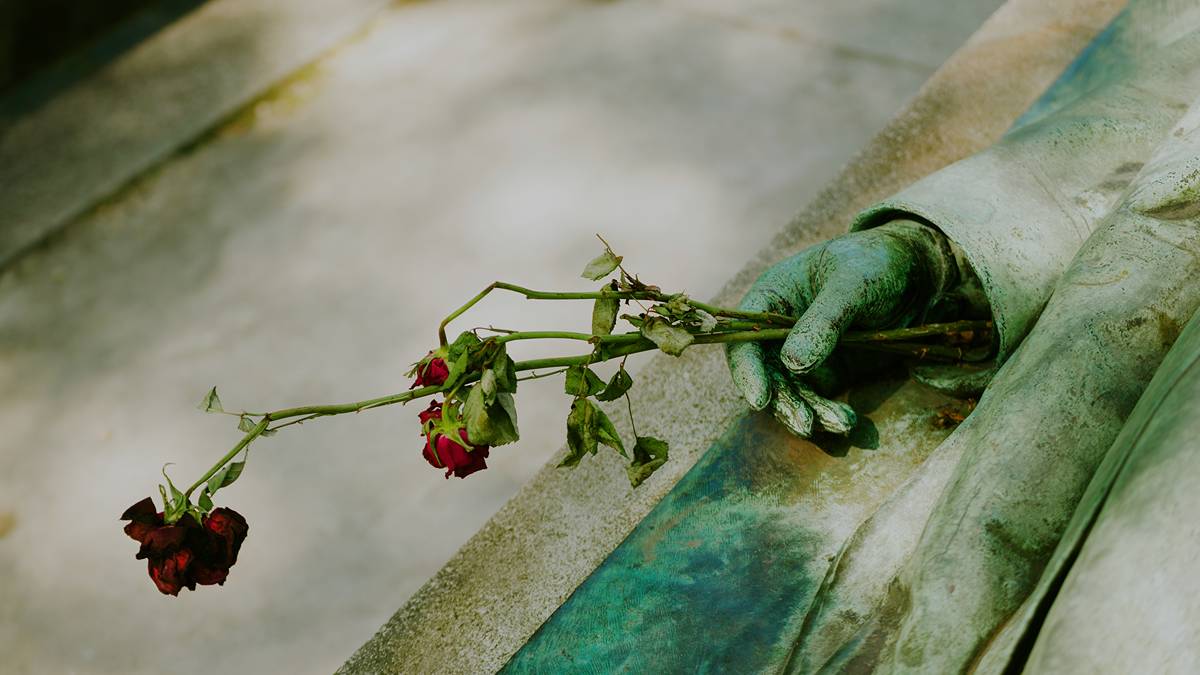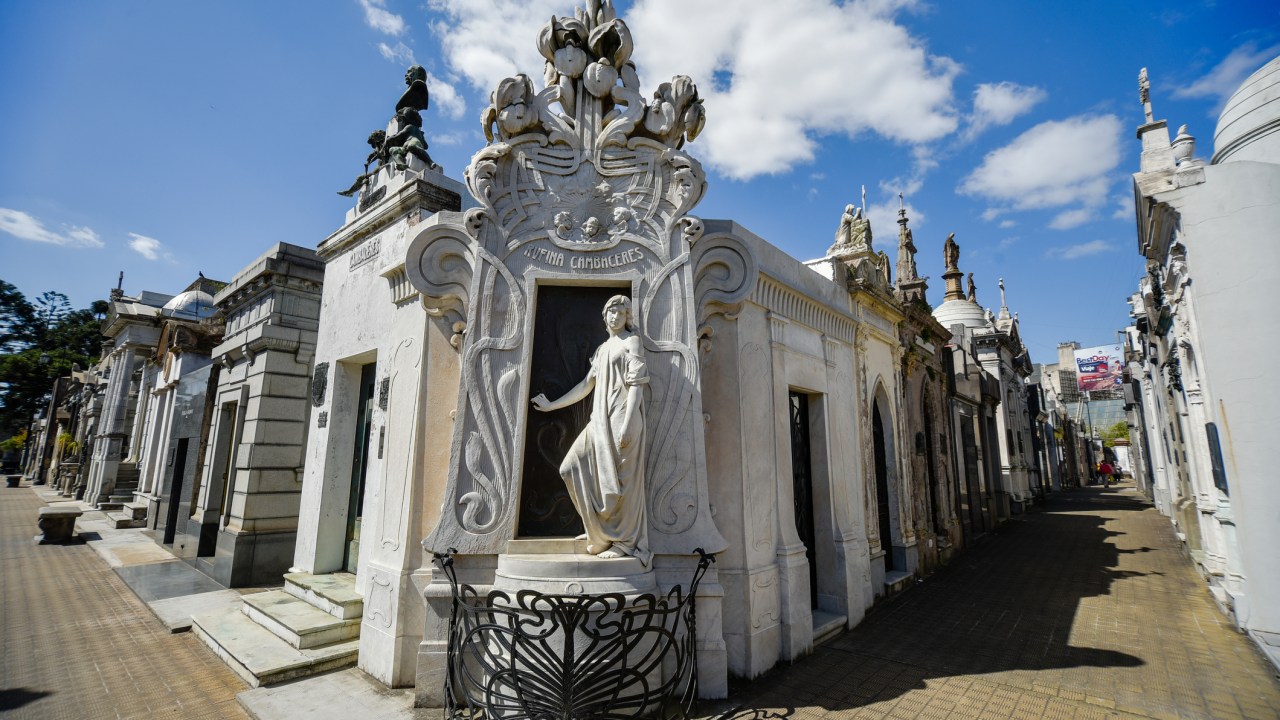The X-rated reason this tombstone was roped off

If there's an afterlife, it's been quite a busy one for Victor Noir. Pic via Getty Images
Some people like cocktails and pools on their holiday. Some like to ski the world’s best powder. Some like to … get up close and personal with tombstones.
Words by Simone Mitchell for Escape
This article may contain links from escape.com.au’s affiliate and advertising partners. Escape may receive payments when you click on links, buy through them or share this content.

There is nothing like an amble through a cemetery to give you a new lease on life. It’s a stone-cold reminder that we’re all going to die, so best make the most of what’s left and and seize the day.
But for some, cemeteries have an even bigger pull – so much so that exploring the graves of notable folk becomes a hobby (and even a motivator for travel). They are known as “tombstone tourists”, “grave hunters”, “gravers”, or “taphophiles”.

Cemeteries aren’t conventional tourist destinations, but they’ve become essential stops for history buffs looking to learn more about the community they’re visiting, writes Scottie Andrew for CNN travel:
“‘Tombstone tourists” are always encouraging more to consider a cemetery’s the macabre beauty”.
“For me, a cemetery is like an art museum,” said Joy Neighbors, an author who writes about her cemetery obsession in the blog A Grave Interest. “It’s always an adventure and always an experience to go in, dig around and see what you can find.”
Philip Stone, founder and executive director of the Institute of Dark Tourism Research at the University of Central Lancashire in the United Kingdom, likened tombstone tourism to “sightseeing the mansions of the dead.”
The term Tombstone Tourist has been most notably used by author and biographer Scott Stanton as the title of his website and book The Tombstone Tourist. He has spent the last 25 years travelling over 1,000,000 miles (1.6mill km) to visit the final resting places of thousands of the famous, infamous and notorious. His website provides cemetery maps, exact directs to the grave (with GPS) and videos for every featured celebrity. You can even search along a road trip you are taking to see if there are any fascinating graves along the way.
Below you will find a selection of some of the more bizarre graves from around the world …

Victor Noir
You would assume when you die you’ll be left well alone. Not if you are Victor Noir. Noir was a famous French journalist who was shot to death in a very high profile incident in 1870 by Prince Pierre Bonaparte (Napoleon’s cousin).
A life-sized bronze statue was sculpted by Jules Dalou to mark his grave. It is quite an arresting piece of art. Noir is portrayed in a realistic style as though he had just fallen on the street, dropping his hat which is depicted beside him.
The grave is located at Pere Lachaise Cemetery in Paris …

As Wikipedia points out, the sculptor was very kind to Noir, stating “the sculpture has a very noticeable protuberance in Noir’s trousers.”
Noir’s generous pantal region has weirdly made his grave a “fertility symbol” …

The myth says that placing a flower in the upturned top hat after kissing the statue on the lips and rubbing its genital area will enhance fertility, bring a blissful sex life, or, in some versions, a husband within the year. As a result of the legend, those particular components of the otherwise verdigris (grey-green oxidized bronze) statue are rather well-worn and shiny, as are the tips of the boots. The internet is littered with images of women astride the grave.
In 2004 a fence was erected around the statue of Noir, with a sign that read “any damage caused by graffiti or indecent rubbing will be prosecuted”. However, due to supposed protests from the “female population of Paris”, in fact led by French TV anchor Péri Cochin, it was torn down again.
Women who have fallen pregnant after visiting Victor Noir’s grave return to the cemetery in gratitude and put photos of their children and other objects in the hat near the statue.

Florence Irene Ford, Natchez City Cemetery
Apparently a heart broken mother had the grave above designed for her daughter, Florence Irene Ford, who died of yellow fever at the age of 10. Before her death, the daughter was terrified of storms. The grave at the Natchez City Cemetery in the US was constructed with an entrance that descends to the level of the coffin. Her mother would come and enter the tomb during storms to comfort her child.

Mary and Jonathan Reed, Greenwood cemetery, Brooklyn New York
When Mary Reed passed away, her husband Jonathan was distraught. According to the New York Times, Reed furnished her tomb “just like a living room in a fine house”—including an oil stove and paintings. He even brought her partially finished knitting, and their pet parrot.
For more than ten years, Jonathan took up partial residence in the tomb, arriving when the gates opened and leaving only when they were closing for the night. Believing his wife could hear him, he chatted with her throughout the day.
Word got out and people started visiting him in the tomb. He had over 7,000 visitors in the first year. Several Buddhist monks even made the pilgrimage believing he had special knowledge of the dead.
In his obituary, the New York Times wrote that “Mr. Reed could never be made to believe that his wife was really dead, his explanation of her condition being that the warmth had simply left her body and that if he kept the mausoleum warm she would continue to sleep peacefully in the costly metallic casket.”
According to the Bushwick Daily, in March 1905, he was found collapsed on the floor reaching out toward Mary’s casket. He was laid to rest beside her, and the mausoleum door was closed and locked.

Rufina Cambaceros, ‘the girl who died twice’ at La Recoleta Cemetery in Buenos Aires, Argentina
On her 19th birthday, Rufina Cambaceros was pronounced dead. She was taken to the cemetery in a coffin and left in the chapel to be interred later.
The next day they found her coffin had moved and the lid was broken in places. Suspecting a grave robbing, the family had the lid opened. Her jewellery was in place but the coffin and her face were scratched. It turns out the teenager wasn’t actually dead – she had suffered cataplexy – a condition where a person stays awake but cannot move.
She died in the casket from a heart attack due to panic and lack of air. Rufina is now represented as a life-size statue opening the door of her own mausoleum.

Colonel van Gorcum and Lady van Aefferden, The Netherlands
These are the graves of a husband and wife who are still holding hands over 150 years after their death. In life, their marriage was frowned upon – she was Catholic and he was Protestant. When he died he was buried in the Protestant section of the cemetery.
Knowing she would be buried in the Catholic cemetery, Lady van Aefferden chose a burial site right by the wall dividing the two cemeteries, as close to her husband’s grave as possible. At the peak of their headstones are two hands holding onto one another.

Greyfriars Bobby in Edinburgh
In Edinburgh, Scotland, the Greyfriars Kirkyard cemetery is home of the memorial for Greyfriars Bobby, a terrier who was said to have stood guard at his owner’s grave for 14 years. Visitors often bring him a stick to play fetch with.
This article first appeared in escape.com.au as The weird and wonderful world of tombstone tourism
Related Topics
UNLOCK INSIGHTS
Discover the untold stories of emerging ASX stocks.
Daily news and expert analysis, it's free to subscribe.
By proceeding, you confirm you understand that we handle personal information in accordance with our Privacy Policy.








